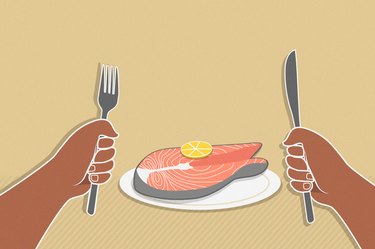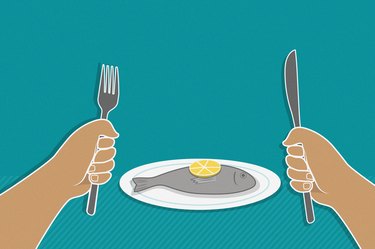
When it comes to nutritious and convenient lunches, it's hard to top canned tuna. Sure, it might smell a little funny, but it's tasty and goes well with a variety of dishes, including sandwiches, salads and tacos.
Canned tuna is usually available as skipjack (light tuna), albacore (white tuna) and yellowfin (light or gourmet tuna) packed in water or oil (such as soybean or olive). But because tuna is a source of mercury, should you avoid eating it daily?
Video of the Day
Video of the Day
Here, we break down the pros and cons of eating canned tuna every day.
The Benefits of Canned Tuna
According to a 2015 study from the USDA, about 80 to 90 percent of Americans don't eat enough seafood. So if you're trying to eat more fish, canned tuna is an easy and affordable way to do it. Here are all the benefits of eating canned tuna every day.
1. It's Rich in Omega-3 Fatty Acids
The 2020-2025 Dietary Guidelines for Americans recommend eating at least 8 ounces of seafood per week based on a 2,000-calorie diet — and eating canned tuna every day is an excellent way to meet that.
"Canned tuna is rich in omega-3s, which are part of essential fatty acids that your body can't naturally produce. Tuna contains two of the most important omega-3s: EPA (eicosapentaenoic acid) and DHA (docosahexaenoic acid)," says LaChell Miller, RD, certified culinarian and representative of the New Jersey Academy of Nutrition & Dietetics.
"Studies show that omega-3s can reduce the risk of heart disease, depression, dementia and arthritis."
A June 2020 review in the Mediterranean Journal of Rheumatology found that omega-3s have an anti-inflammatory effect that helps with lowering joint stiffness and tenderness in people with rheumatoid arthritis, an autoimmune disorder in which the body attacks the joints.
Omega-3 fatty acids are specifically good for reducing harmful triglycerides in your blood, reducing the risk of developing an irregular heartbeat, slowing the build-up of plaque in the arteries and lowering blood pressure, according to the U.S. Library of Medicine.
Omega-3s may also help prevent or delay cognitive decline in the early stages of Alzheimer's disease, but longer, randomized trials are needed to determine the exact dosage for delaying the progression of cognitive decline associated with Alzheimer's, according to an August 2015 review in BioMed Research International.
2. It's an Excellent Source of Lean Protein
One 3-ounce portion of canned tuna has 22 grams of protein for just 100 calories, per the USDA.
Canned tuna is a great source of lean protein, so it helps keep you full longer and prevents cravings, says Bonnie Taub-Dix, RDN and author of Read It Before You Eat It: Taking You from Label to Table. Lean protein not only helps curb hunger and cravings, but it aids in muscle repair after a tough workout.
In fact, the Food and Drug Administration (FDA) lists canned light tuna as one of the best protein sources that's also low in mercury (more on that below).
3. It's Affordable and Shelf-Stable
"The great thing about tuna is that it's very affordable and accessible. You can buy tuna canned or in packets, and they come in different flavors," Taub-Dix says.
Taub-Dix says that canned tuna in water or oil are both good options, but she personally likes to get tuna packed in water and add her own healthy fat, like avocado slices.
"It also has a very long shelf life, and you can probably buy them in bulk on sale."
The Health Risks of Eating Canned Tuna Every Day
1. Mercury Content
"Mercury is a heavy metal found in the air, water and soil. A person can be exposed through inhalation through the atmosphere, dental fillings and through fish and shellfish," Miller says.
If you eat a lot of seafood, you might be concerned of methylmercury exposure — a form of mercury that destroys nerve tissue — from canned tuna.
Overexposure to methylmercury can cause symptoms, such as loss of peripheral vision, muscle weakness and impaired speech, hearing and walking, according to the Environmental Protection Agency (EPA).
Fish absorb mercury from water pollutants. Predator species, such as tuna, that live longer tend to have the most exposure, Miller explains.
That said, "The FDA looks at upper limits of weekly seafood consumption and notes that you would need to eat 164 ounces (10 pounds) of light canned tuna and 56 ounces (3.5 pounds) of albacore white tuna per week before being at risk for mercury," Miller says. "Therefore, having 3 ounces of canned tuna daily (21 ounces per week) isn't going to put you at risk for overconsuming mercury."
The FDA classifies fish into three categories based on their level of mercury: best choices, good choices and choices to avoid.
People who are pregnant or breastfeeding can enjoy two to three servings of fish each week from the "best choices" list, which includes canned light tuna.
Yellowfin tuna and canned albacore tuna are on the "good choices" list, which pregnant and breastfeeding people can eat once a week but avoid eating other fish. You want to avoid eating bigeye tuna altogether because it is one of the fish with the highest mercury levels.
Meanwhile, children should eat two servings of fish weekly from the "best choices" list at smaller portion sizes than adults, per the FDA. Their serving sizes depend on their age. For example, one serving of fish is 1 ounce for children ages one to three, and 2 ounces of fish is one serving for children ages four to seven.
"Some canned tuna brands to look for that have lower levels of mercury include Safe Catch and Wild Planet," Taub-Dix says. According to Safe Catch, they test every fish for its mercury content and have stricter limits for mercury levels in canned wild and wild albacore tuna than the FDA.
Tip
For sustainable canned tuna options, check out Monterey Bay Seafood Watch's complete list and tips on what look to look for on labels to ensure that the fish was responsibly caught.
2. Sodium
Although canned tuna does contain salt, it only provides a moderate amount of sodium. "Low-sodium foods have 140 milligrams or less per serving, and canned tuna has around 200 to 210 milligrams per 3-ounce serving," Taub-Dix says.
When considering the sodium content of canned tuna in your everyday diet, it's not as much compared to eating a bag of chips or even a can of soup, which are much higher in sodium, for example.
FYI, more than 70 percent of sodium the average person eats comes from packaged foods, according to the American Heart Association. So if you're looking to cut back on the salt, consider reducing the amount of packaged snacks and meals you eat.
"When looking at sodium content, it's important to read the label. Anything under 5 percent Daily Value (DV) will indicate low-sodium. A 3-ounce can of light or regular tuna packed in water or oil will contain around 13 percent DV, which is a moderate amount of sodium," Miller says.
"Choosing canned tuna that is labeled 'no salt added' will have around 50 milligrams of sodium (2 percent DV) and is therefore low-sodium."
Tip
If you're concerned about sodium, look for canned tuna varieties that say "no salt added" on the label, as "light" doesn't guarantee that it's low-sodium, Miller says. "It's also recommended for weight management and heart health to buy tuna packed in water to save on total fat and calories."
So, Is Eating Canned Tuna Every Day Bad for You?
The benefits of eating canned tuna every day outweigh the risks. Because canned tuna provides omega-3 fatty acids and is a lean source of protein, there's no harm in adding it to your daily diet.
"Mercury levels are very low, and canned tuna is the most economical and accessible way to consume omega-3s," Miller says. "Tuna also provides some potassium, calcium and choline, so overall, it's a great food to add to your diet," Taub-Dix says.
Most people can enjoy it every day, but avoid having it at every meal and be mindful of your overall sodium intake. Those who have high blood pressure, a heart condition or a kidney issue may want to consider low-sodium canned varieties.
The USDA Dietary Guidelines recommend that adults enjoy at least 8 ounces of seafood per week (based on a 2,000-calorie diet), which you can divide into two 4-ounce servings. You can have up to 12 ounces of seafood (three 4-ounce servings) per week.
If you're pregnant or breastfeeding, you want to stick to two to three servings of seafood from the "best choices" list, such as canned light tuna or other fish lower in mercury, a week so don't eat it every day. Or, you can eat one serving from the "good choices" list, which includes canned albacore and yellowfin tuna — just don't eat other fish that week if you're having one serving from the "good choices" list.
"Albacore tuna, aka white tuna, is higher in mercury than light/skipjack," Miller says. Avoid fish with the highest mercury levels, including bigeye tuna, per the FDA.
Tip
When making tuna salad, try swapping mayo with Greek yogurt, Miller suggests. You can also mix in fresh herbs like parsley, or cayenne for a hint of heat. Add onions and cucumbers for a Mediterranean-inspired salad. Try tuna salad on a whole-wheat pita, wrap or crackers for a protein-rich afternoon snack.
"Canned tuna cakes are also an affordable swap to the classic crab cakes. Using lemon, garlic, hot sauce, Dijon mustard, scallions and Worcestershire can take your tuna cakes to another level and makes the perfect seafood burger or addition to a salad," Miller says.
- U.S. Department of Agriculture: "Consumers Missing Out on Health Benefits of Seafood Consumption"
- U.S. Dietary Guidelines for Americans 2020-2025
- Mediterranean Journal of Rheumatology: "The Effect of Omega-3 Fatty Acids on Rheumatoid Arthritis"
- U.S. Library of Medicine: "Omega-3 fats - Good for Your Heart"
- BioMed Research International: "Omega-3 Fatty Acids in Early Prevention of Inflammatory Neurodegenerative Disease: A Focus on Alzheimer's Disease"
- Food and Drug Administration: "Advice About Eating Fish"
- Environmental Protection Agency: "Health Effects of Exposures to Mercury"
- Food and Drug Administration: "Technical Information on Development of FDA/EPA Advice about Eating Fish for Those Who Might Become or Are Pregnant or Breastfeeding and Children Ages 1-11 Years"
- American Heart Association: "How Much Sodium Should I Eat Per Day?"
- Monterey Bay Seafood Watch: "Tips for Choosing Sustainable Canned Tuna"
- Seafood Nutrition Partnership: "Mercury in Seafood: What You Need to Know"



